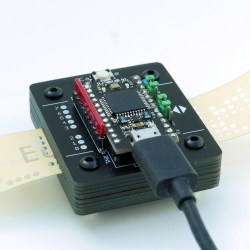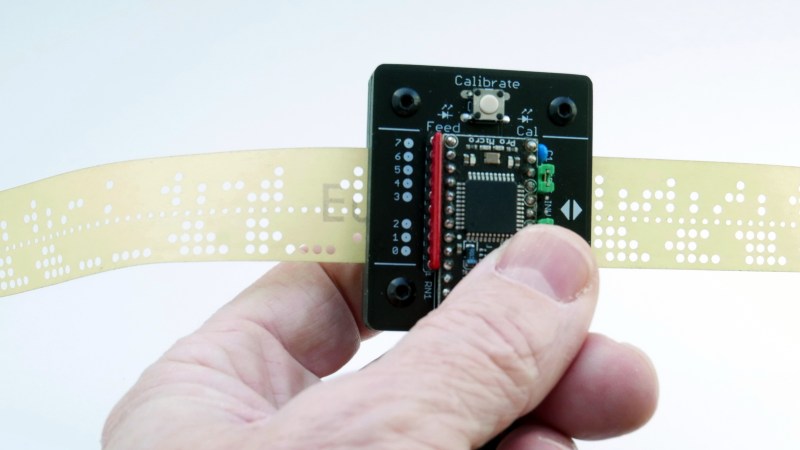Input devices consisting of optical readers for punched paper tape have been around since the earliest days of computing, so why stop now? [Jürgen]’s Paper Tape Reader project connects to any modern computer over USB, acting like a serial communications device. Thanks to the device’s automatic calibration, it works with a variety of paper materials. As for reading speed, it’s pretty much only limited to how fast one can pull tape through without damaging it.

While [Jürgen]’s device uses LEDs and phototransistors to detect the presence or absence of punched holes, it doesn’t rely on hardware calibration. Instead, the device takes analog readings of each phototransistor, and uses software-adjusted thresholds to differentiate ones from zeros. This allows it to easily deal with a wide variety of tape types and colors, even working with translucent materials. Reading 500 characters per second isn’t a problem if the device has had a chance to calibrate.
Interested in making your own? The build section of the project has all the design files; it uses only through-hole components, and since the device is constructed from a stack of 1.6 mm thick PCBs, there’s no separate enclosure needed.
Paper tape and readers have a certain charm to them. Cyphercon 4.0 badges featured tape readers, and we’ve even seen the unusual approach of encoding an I2C byte stream directly onto tape.















Nicely made, nicely documented.
I almost wish I had a need for a paper tape reader!
maybe if the price of microchips keeps increasing you’ll have to go back to it. the atmega32u4 featured is $31 on jlcpcb and the older atmega328 is $57
With the current semiconductor shoartages, the individual ATmega32U4 microcontrollers have indeed become very hard to find and expensive. But the little Arduino-style board used in this project (Sparkfun Pro Micro or no-name clone) is still available at reasonable prices.
Before colossus, I think it was heath Robinson that read punch tape, from memory I think it was around 2000 or 5000 chars per second, breaking tape was the main problem.
Heath Robinson used a mechanical sprocket because 2 tapes had to run together at the same speed. This caused the tapes to damage and destroy themselves.
Colossus only used one tape which optically read the data and the sprocket holes. this enabled colossus to run very fast.
*5000cps* (53mph) was used in the early *1940s*, in Colossus. The tape tended to stretch a little. https://en.wikipedia.org/wiki/Colossus_computer
1000cps used to be standard in the 70s, stopping and starting instantly. The paper tape on a 6inch reel was pulled through the reader by a grip wheel. It flew 6ft across the room, and landed in a 6ft by 3ft by 3ft bucket. It was then respooled by hand.
Yes, you kept you hand out of the way, lest you sustain an enormous paper cut!
Punching tape was much slower, unsurprisingly.
In grad school we had a teletype; as most of you know it was slow as blazes. The spool of paper tape used to load BASIC (I think) took over an hour to load to the computer—I think it was an Altair 8800. The prof built a device just like the one shown here but bigger (of course! After all, it was 1979). He would pull the tape through the reader while two students kept it feeding smoothly on the other side. Took about a minute. Then…Lunar Lander! :-)
There was at least one commercial tape reader back then that was standalone and cheap. 8 sensors, I think some schmidt triggers, and of course the mechanics to keep the tape straight as you pulled it through.
There was a brief time when paper tape was used for distribution. A cheap small reader was fine, since you yourself weren’t punching tapes.
Darn! And I just threw out those tapes from my 1967 sophomore IBM 1620 programming class.
The lack of printers though!
Since we are on the subject, where does one get blank paper tape? (I mean aside from the eBay russian stuff) or has anyone come up with a good way to make it or derive it?
I have a punch, I was going to do a little side gig punching paper tape for people but I’m limited to cash register tape which works but doesn’t have the desired authenticity.
I’m curious too. I’m pretty sure you can order some 11/16 or 1 inch paper somewhere.
https://www.circuitousroot.com/artifice/telegraphy/tty-stuff/supplies/index.html mentions WNC Supplies, but the links are dead.
I was going to mention Western Numerical Control out of Phoenix AZ, but I haven’t used them for a few years (since maybe 2016?) and their website seems to be defunct.
Ebay shows a fair number of listings in paper and mylar, and I would be unsurprised if 1″ polyester NC tape is available via one or another of the indusrial suppliers- they can be VERY creative in sourcing non-catalog items.
(Still have a roll or two on the shelf, but I’m not letting it go. I think I still have a manual correction punch in storage, too)
(Supposed to be a reply to DougM… sorry)
I was thinking about tyvek. On the one hand it would really cool and probably bulletproof; on the other I’d hate to destroy my punch, the are hard to find :-)
Thanks for the feedback. I too have 3 rolls of the original stuff on the shelf, thought it’s discolored over time so the edges might be browner than the center.
I will probably see how much a custom run will cost.
Isn’t the tape oiled so to lubricate the punch? They used to stain your printouts if you weren’t careful
Paper tape for ASR-33/35 Teletype (TTY) was indeed oiled and sometimes messy. However, paper tape for the fancy DEC paper tape readers was specified as unoiled (since the oil would probably gum up the optical sensors?). TTY reader had mechanical pin sensors. I miss that sound. Find it hard to believe how reliable they were!
Speaking of Lunar Lander, here’s a short video I did for VCF Midwest. Loading paper tape BASIC on an HP 2108A minicomputer with a 2748B reader (500cps), then loading and running Lunar Lander.
http://q7.neurotica.com/Oldtech/HP/2108A/PaperTapeEdited.mp4
The 2108A is from 1975 and the 2748B from 1973.
Now I need to find my old copy of “Altair Basic” from the “Micro Soft corporation”. ;)
I remember the days when I programmed a NC (not CNC) drill through the teletype 33 paper tape punch. I also remember it jamming now and again. Then I would cut it at the last readable block. Rethread the tape through the punch and type a bunch of deletes (all holes punched) for easing the splicing later. Then set the NC to the zero point and run the piece I cut off to get to the last programmed drill point (the moves were incremental not absolute so you needed all the prior coordinates to get there.) And restart the programming. Oh joy!
The links for schematic, gerbers, etc., come up garbage (raw xml) on chrome and firefox. Says no style info available.
Without those goods, not much use.
Ah, those browsers are getting too smart… The Eagle files (schematics and board layout) *are* raw XML files. Just save them, either after you have opened them in the browser, or by right-clicking the link and choosgin “save link as…”.